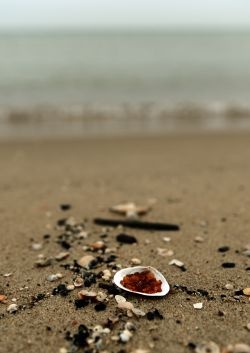‘Baltic gold’, a prehistoric organic treasure

Here, amber is known as « Baltic gold ».
Rich veins of this 40-million-year-old fossilised tree resin running along the coast have fuelled a centuries-old trade in the northern port city of Gdansk, making it the amber capital of the world.
Deftly crafted beads, bracelets and amulets dating back to the Neolithic Age attest to the timeless appeal of this sensuous organic treasure.
Combing local beaches for precious golden nuggets is a ritual here harking back centuries, if not millennia.
It has become a life-long passion for Wlodek Janowski, a burly 53-year-old retired mechanic and amateur boxer. A good storm often brings with it what he calls a « Baltic gold rush ».
« With any luck after a gale, you can find a couple hundred grammes (seven ounces) of amber in just one day, » said Janowski, pouring out about a dozen irregular pieces from a pocket in his chest waders.
Wlodek’s treasures, ranging in colour from honey gold to dark molasses, can reach the size of golf balls.
The world’s largest known piece of raw amber — now kept in Berlin — weighs 9.75 kilogrammes (21.5 pounds).
Experts say amber crafting first began in neolithic times some 5,000 years ago.
Today, the going rate for amber starts at 10 euros ($13) per gramme but can be much higher depending on the quality of the specimens. Pieces that include insects, small lizards or vegetation are rare and very precious.
Baltic amber originated in the primaeval coniferous forests of what is now Scandinavia upwards of 40 million years ago.
Over the eons, the resin that oozed from the trunks of ancient pines was fossilised and washed by a long-gone river into the Baltic Sea.
It comes in more than 300 varieties, some specimens sparkling like champagne with tiny prehistoric air bubbles, others swirling honey and butter colours together.
Pieces with a blue-green tinge are the rarest and most valuable.
Amber deposits in Poland and nearby Kaliningrad and Lithuania are estimated at 650,000 tonnes, easily the world’s largest concentration.
Smaller amber deposits are spread across the globe from Canada to South America and Australia, through to Africa and Asia as well as the Middle East.
In Poland, most deposits lie around 90 metres (300 feet) underground and are costly to mine. But Kaliningrad, with its own plentiful amber caches closer to the surface, provides a less costly source of raw amber for Gdansk artisans.
— Lucjan Myrta, the ‘amber king’ —
Gdansk registered its first amber artisans guild in 1477. The sector flourished in the 16th to 18th centuries when amber treasures were crafted for the aristocracy.
Today, the city’s amber sector is feeling the pinch of the 2008 economic crisis and has shrunk by more than half from a heyday a decade ago when it employed around 13,000 people.
« Because of the crisis, the largest ateliers have let go half of their employees, while many of the smaller ones have shut down completely, » Mariusz Gliwinski, vice president of the Gdansk-based International Amber Association, told AFP.
But the city still boasts hundreds of ateliers producing amber jewellery and objets d’art, the unrivalled annual Amberif amber trade fair and a museum dedicated to the gemstone.
And if Gdansk is the world’s amber capital, Lucjan Myrta is its unrivalled craftsman-king.
In his sprawling mansion in a leafy Gdansk-area suburb, Myrta, 66, has created an amber trove quite possibly second in opulence only to St. Petersburg’s fabled amber room, which vanished during World War II.
Myrta is the creator and owner of what he claims is the world’s most extensive amber art collection, boasting hundreds of pieces.
Among them, the world’s second largest hunk of raw amber — weighing 5.95 kilogrammes (13 pounds) — and a meticulously crafted treasure chest standing 2.75 metres (nine feet) high, the only one of its kind in the world.
His carved amber « paintings » seduce with the fluid Impressionist style of French master Claude Monet or the voluptuous floral curves of Art Nouveau.
« I can’t put a price tag on it all, it’s my labour of love, » he told AFP.
Plans are afoot for the entire collection to go on display in Russia, Saudi Arabia and possibly France.

